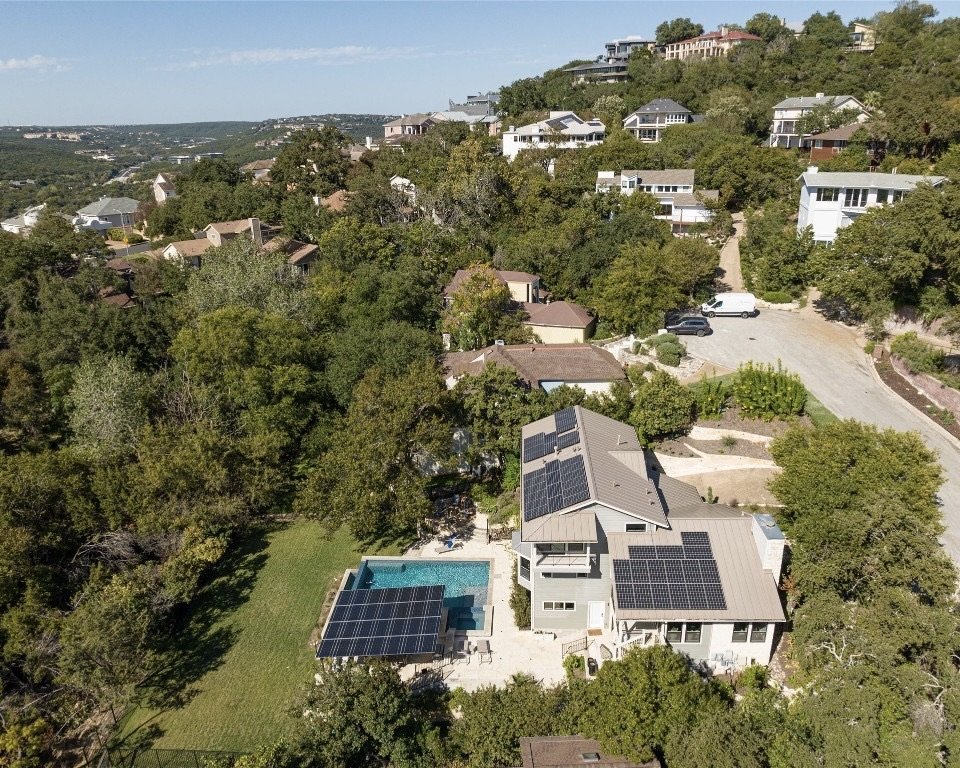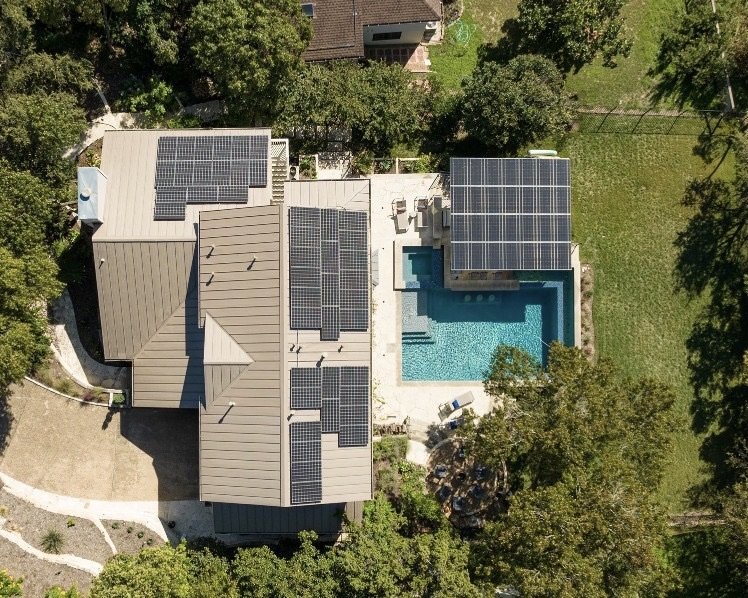As an architect who designs energy-efficient homes, one of the most common questions clients ask me is if they should install photovoltaics on their Austin home. So, in this post, I’ll share reasons to go solar and how to determine if it’s a wise investment for your Austin home.
Although there are a few scenarios where solar panels aren’t ideal, for the most part, they offer many practical benefits. Photovoltaics are a fantastic ‘active strategy’ to generate surplus power when it’s added to a home that’s designed for energy efficiency with ‘passive strategies’. When added to an inefficient home, it certainly offsets the high costs of utility bills.
In our sunny climate, solar energy is a fantastic renewable resource to tap into, whether you just want to be prepared for those power outages or want to build a net zero home.
First, how does a solar panel system work?
Simply put, a solar panel system works by converting sunlight into electricity. TLDR: A photovoltaic (PV) charge creates direct current (DC), which is then converted into alternating current (AC) by an inverter. AC is the primary way to fuel a home. While it can flow directly to your circuitry, you can also store it in a battery and use the reserves during power outages.
Here are the 5 components of a solar system and how it works together:
Solar Panels:
A solar panel contains a group of photovoltaic (PV) cells. Each cell is made of semiconductor materials, usually silicon, which absorbs sunlight energy and releases electrons, thus generating an electric current. Typically, you’ll have an array of solar panels, all connected together. See more info about different types of solar panels below.
Inverter:
The electricity produced by the solar panels is direct current (DC). An inverter is required to convert DC into alternating current (AC), which is the type of electricity provided by the power grid and what most household appliances run on.
Electrical Panel:
The AC electricity flows from the inverter to the electrical panel, also known as a breaker box. From here, it is distributed to power lights, appliances, and other electrical devices in the home.
Utility Meter:
If the solar panels produce more electricity than is needed or used by your home, the excess can be fed back into the power grid through the utility meter. Many power companies use net metering, allowing homeowners to receive credits for the excess electricity they generate. Power companies may purchase your electricity through a Value of Solar (VOS) buyback plan.
Battery Storage (optional):
You can opt to include batteries to store excess electricity for your own use when the sun isn't shining or when the power grid is down, thus providing you with a backup power source. A battery system is required when you live off-the-grid.
The size of your system will depend on whether you plan to use it as a supplementary energy source or as your sole energy provider.
Overall, a solar panel system provides a renewable, free, and clean source of energy by harnessing sunlight and converting it into usable electricity.
Components of solar - Inverter, PV Meter, and Electric panel
5 compelling reasons why solar energy is a good investment for your Austin home
Here are some reasons why you might want to incorporate an alternative power source in your home.
1. Rebates and incentives
Solar rebates are some of the highest in the federal rebate program, making it the top reason to install solar panels. This may change, but as of April 2024,
You can get a $2,500 rebate on qualifying PV systems that are at least 3 kWh in size. To apply for it, take the Solar Education Course and quiz.
Another incentive is the Value of Solar Bill Credits which offers a 9.91 cents/kWh credit that can lower your electric bill. For example, if you used $120 worth of electricity in a month and your solar panel system produced energy equal to $114, you’ll only pay $6. Similarly, if it produced $135 worth of energy, the excess will get carried over.
You may also be eligible for a 30% federal solar tax credit that offers a reduction in your income taxes.
Lastly, you could qualify for a property tax exemption when you mount solar panels on your roof. However, I’m unsure how beneficial that could be since it lacks a grandfather clause which can seriously impact your return on investment.
2. Lower utility bills
Austin Energy’s residential rates follow certain tiers. This means that the more energy you consume, the higher your bill.
Luckily, a solar panel system can potentially offset your grid power consumption.
Additionally, Austin is scheduled to implement a 5% increase to the Power Supply Adjustment (PSA) rate beginning March 24, 2024, so installing solar panels could offer you some protection against inflation.
3. Increase property value
According to the real estate platform Zillow, residences equipped with photovoltaic energy systems sold for 4.1% more on average than ordinary homes. Meanwhile, the National Renewable Energy Laboratory estimates that every dollar saved on electric bills through solar panels increases a home’s values by $20.
As home buyers are becoming more conscious about the environment, the demand for solar panels is higher than it’s ever been. How much exactly they contribute to home values depends on where the property is located and the quality of the solar energy system.
Note, however, that a house with solar panels doesn’t automatically become more expensive. If the system is poorly designed, outdated, inefficient, or isn’t functioning, it will negatively affect the home’s value.
4. Helps you enjoy continuous power
The 2021 Texas Freeze affected more than 4.5 million homes, proving that the state’s electricity supply requires greater oversight. Aside from the inconvenience of not being able to use home appliances, power failures have several notable disadvantages:
Damage to electronics
No air conditioning or heating
Risk of carbon monoxide poisoning (the fuel used to produce alternative energy sources for cooking, cooling, and heating can lead to a hazardous build up of carbon monoxide inside a home)
Refrigeration loss, leading to food spoilage
It’s no wonder that so many homeowners are looking to equip their homes with solar energy. In fact, a significant percentage of the population has already adopted it, prompting the Frontier Group to rank Austin as one of the cities with the most solar photovoltaic (PV) capacity in 2022.
5. Lower environmental impact
About 40% of the total energy consumed in the United States is used to generate electricity. This has a massive environmental impact. It increases the carbon dioxide and greenhouse gas emissions in the atmosphere along with other pollutants.
By harnessing solar energy, you can lower the rate of climate change. Consider this—an acre of solar panels can reduce more emissions annually than an acre of trees. Research also suggests that most solar panel systems installed in homes can reduce our annual carbon emissions by 3 to 4 tons. That’s like planting over 100 trees a year!
Like electric vehicles, solar panels do not produce any greenhouse gases, however, electric vehicles still rely on electric grids which may draw power from power plants that produce harmful fumes (e.g. coal-powered plants).
The Photovoltaic Panel Technology
There are four types of PV panels.
Monocrystalline solar panels
Sometimes called single-crystal panels, these panels employ a single pure silicon crystal that is divided into several pieces. They are ideal for small spaces and last the longest. Since it takes a lot of silicon to manufacture a monocrystalline cell, this type of panel is very expensive. Tesla’s Solar Roof, uses this type of panel. The Tesla Solar Roof comes with a battery called Powerwall.
2. Polycrystalline solar panels
Polycrystalline panels utilize several silicon crystals. Silicon is melted and poured into square molds, resulting in less waste and a lower price tag. They are larger than monocrystsalline systems, less efficient at energy conversion, and cannot tolerate very high temperatures.
3. Passivated Emitter and Rear Cell (PERC) solar panels
These offer higher efficiency than conventional monocrystalline cells because of the way they process light. They collect more energy while taking up less space and are less expensive than traditional panels.
4. Thin-Film solar panel variations
Thin-film solar panels are not made from crystalline panels and silicon. They’re manufactured from different materials like amorphous silicon, cadmium telluride, and copper indium gallium selenide. The raw materials determine the panels’ efficiency and cost.
FAQs
How much does it cost to install Photovoltaic Panels?
Here’s the all-important question for most families —can you afford it? You’ll be glad to know that the cost of photovoltaic panels has been dropping steadily since 2009 as the demand for renewable energy continues to grow. In the last decade, prices have gone down by over 50% in the residential space, and the downhill trajectory is expected to continue. It’s a good idea to take advantage of solar panels now while there are tax incentives and rebates available, especially since it’s uncertain how long they will be offered.
Now, let’s talk prices. EnergySage reported that 5kW solar panel systems in Austin cost between $10,000 and $14,000. While that may still be several thousand dollars too expensive for many homeowners, funding from SETO can help offset the cost of your initial investment.
There are also rebates and incentives to consider.
Are there any solar energy rebates and incentives for Austin homeowners?
To encourage more people to have solar panels installed, there are certain rebates and incentives in Texas that you can take advantage of:
The Value of Solar Bill Credits offers a 9.91 cents/kWh credit that can lower your electric bill. For example, if you used $120 worth of electricity in a month and your solar panel system produced energy equal to $114, you’ll only pay $6. Similarly, if it produced $135 worth of energy, the excess will get carried over.
Austin homeowners can also avail of the Austin Energy Solar Rebate which offers a $2,500 rebate. Customers of Austin Energy may qualify for it by taking an online solar education course and hiring an Austin Energy Participating Contractor to install their systems. You can check out the full list of requirements here.
Lastly, you could qualify for a property tax exemption when you mount solar panels on your roof. However, I’m unsure how beneficial that could be since it lacks a grandfather clause which can seriously impact your return on investment.
What’s the return on investment?
You can calculate your return on investment (ROI) in 2 ways: payback time and the lifespan of your solar panel system.
payback time
A typical payback period for a residential solar system is 7 to 10 years.
Of course, this will vary based on factors like the system size, amount of sunlight the home receives, local energy prices, utility rates, incentives on offer, and so on.
Want to get a rough estimate for your home?
Take the costs of the solar panel purchase and installation. Subtract the rebates and incentives from the government and monthly savings on utility and you get your payback period.
For example, suppose you spent $20,000 on photovoltaics and received a $2,500 rebate from Austin Energy. That brings your expenditure down to $17,500. Assuming it reduces your yearly electricity bill by $1,500, it will pay for itself in 11 to 12 years.
2. system lifespan
Solar panels don’t have many moving parts, so a good system will last around 25 to 30 years before its efficiency starts to degrade and produce less energy.
This means that if you’re saving $1,500 a year on energy bills (not considering fluctuations in utility rates) with photovoltaics, you’ll be able to pay back the cost of the energy system and enjoy big savings throughout its lifespan.
Since most residential solar panels remain operational for around 25 years, conservative estimates illustrate that you can save $21,000 if your system lasts for 14 years to $28,500 for a system that lasts 19 years.
When does it make sense to consider PV systems?
As an architect with twenty-plus years of experience designing energy-efficient custom homes, I generally recommend PV systems for all-electric homes. Electric-powered HVAC systems and water heaters are energy hogs and are responsible for the majority of utility bills. So an all-electric home will have higher bills than a home that uses gas for heating and cooking. Using solar energy to offset the high utility cost will reduce your ROI timeline.
Alternatively, if you want to be self-sustaining or you want to live in a net-zero home (a home designed and built to only use the energy it produces), PV systems are a smart choice.
Does your home meet the requirements for PV systems?
Not all homes are good candidates for a solar panel array. Here are some examples where you might want to think twice:
Roofs with a steep slope. Your best bet is a south-facing (or west as a second resort) roof with a 10 to 40-degree angle for maximum exposure.
Rooftops in serious need of repair. Ideally, it should be stable and sturdy enough to last the lifespan of the solar panel system without requiring replacement.
Rooftops that don’t get enough sun due to tree cover or improper orientation. This limits the amount of energy that the panels harness.
Roofs with insufficient surface area. The roof is either divided into several small surfaces or not large enough to accommodate the panels.
If your roof is not a good surface for a solar array, but you have the land area to support one, consider a ground-mount solar system.
What type of roofing material is best for PV systems?
Among the different roofing materials, standing seam metal is the top choice but clay tile and composite shingles can also work.
Do solar panels come with a battery?
When you buy panels, they usually don’t include a battery. So it is a separate purchase.
Architecture by George:
for contemporary, energy-efficient, Austin custom homes
In my humble opinion, generating solar energy is an “active strategy” that is supplemental to good design for an energy-efficient home. When slapped on a typical American house that is an energy hog, it is missing the point.
At Architecture By George, my goal is to design homes that are conscious about energy usage. The main aim is to minimize heat gain (the metric that is pertinent to the hot-humid climate in Austin), so we don’t use as much energy to cool the house down. I employ “passive design strategies” that acknowledge the climate, and build a house that uses less energy. We use measures to lower your energy costs - high-performance systems and materials, such as insulated glass windows and doors, better insulation and ac systems, optimizing the building envelope, minimizing infiltration and thermal bridging, etc.
If you have questions about whether or not photovoltaics are right for your Austin home, lets talk. You can schedule a free call with me, Sharon George. We can go over some ideas and find the best solutions to help you realize the home of your dreams.
Whether you’re looking to build a new home or renovate an old one, I’m ready to help.
Cheers,
Sharon George.





